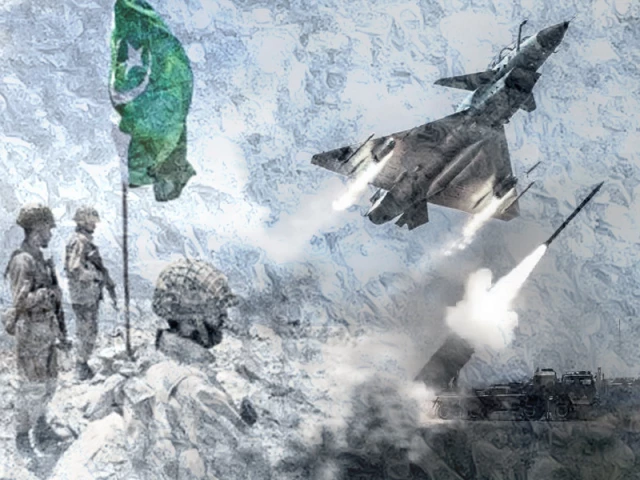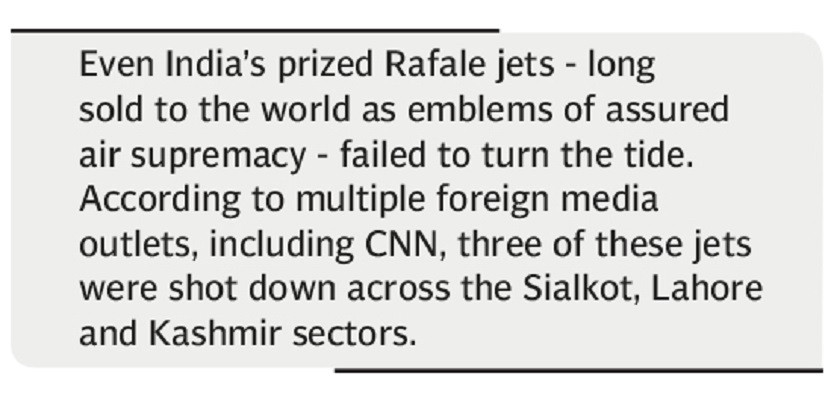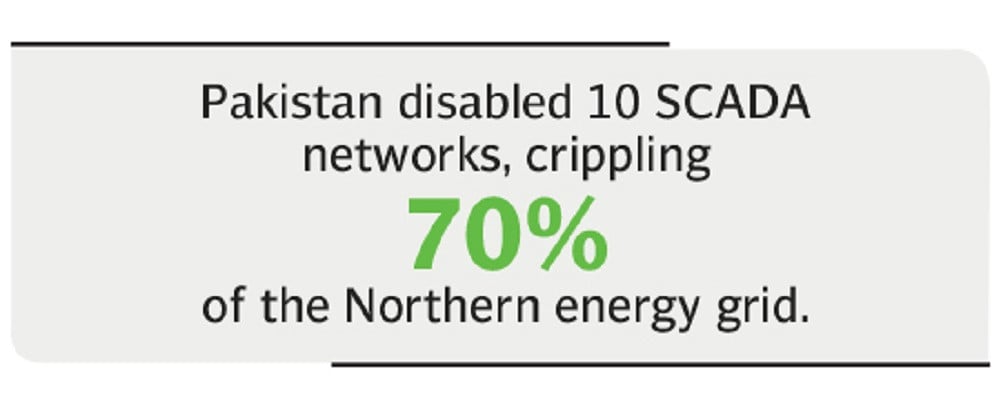Indo-Pak war 2025: Pakistan has the last laugh
Retaliatory strikes targeted not just troop concentrations and air assets, but the very spine of operational command

In the early hours following India's unprovoked attack, Pakistan's Armed Forces launched a calibrated response - code-named Operation Bunyanum Marsoos - one that not only neutralised incoming threats and gripped the world's attention instantly, but also sent a clear message to New Delhi the skies above Pakistan would not be ceded to aggression or violations of national sovereignty.
What unfolded was not just a military response, but a moment of rare operational clarity - drones intercepted, air dominance reasserted, and command over the slaloming narrative of victory, being spun by India's media apparatus loyal to Prime Minister Narendra Modi, reclaimed with measured confidence - all in one fell swoop, under the banner of Operation Bunyanum Marsoos.
Behind the scenes, coordination between the Pakistan Air Force, Army, and Navy ensured the response was not only proportional, but tactically above India's capabilities. The military's top brass, appearing in a rare tri-services media briefing, conveyed calm precision - a sharp contrast to their visibly tense Indian counterparts, who, hours later, struggled to account for the precise outcome in both numbers and detail before a press corps that had largely toed the government's narrative throughout the escalation - one triggered by a barrage of Indian missiles and breaches, but concluded by Pakistan's response.

For Pakistan, what began as a military counter quickly transformed into a full-spectrum show of force. Its retaliatory strikes targeted not just Indian troop concentrations and air assets, but the very spine of India's operational command - from missile silos to drone fleets, air defence shields to digital firewalls. In a tightly coordinated air offensive, Pakistan neutralized 26 high-value military installations across five Indian states, leaving behind what experts have described as structural wreckage and tactical disarray for their opponent.
At Beas and Nagrota - sites used to launch attacks on Pakistan that killed over 30 people - BrahMos storage facilities were reduced to ashes. In Udhampur, security officials from Pakistan revealed, India's prized S-400 air defence systems - the crown jewel of its aerial shield - were obliterated in minutes. Pathankot Airbase, long considered a frontline launchpad, they confirmed, was rendered inoperative, its runways crumpled and hangars charred. The logistics hub in Jalandhar came under sustained precision fire, triggering secondary explosions and cutting off crucial supply chains.
According to officials, by the time Pakistan's strikes reached Nagrota, Akhnoor and Uri, the writing was on the wall of India – not only would aggression be met with force, but its military calculus had evolved - leaner, faster, and digitally lethal.
Assault on Srinagar's Northern Command HQ - which left over 21 confirmed dead, officials said, sent shockwaves through India's northern military belt. Chandigarh's weapons depot and communications grid were similarly compromised, as was the airfield at Suratgarh, pushing Indian Air Force operations into retreat.
Even India's prized Rafale jets - long sold to the world as emblems of assured air supremacy - failed to turn the tide. According to multiple foreign media outlets, including CNN, three of these jets were shot down across the Sialkot, Lahore and Kashmir sectors.
As Operation Bunyanum Marsoos continued, it also chipped away at the Bharatiya Janata Party's (BJP) official narrative, stirring unease within Prime Minister Modi's inner circle. Meanwhile, news of destruction from Pakistan’s retaliation spread widely, prompting authorities to block over 8,000 social media accounts, including BBC Urdu, by executive order.

Speaking to Al Jazeera about the damage caused by Pakistan's retaliatory strikes, Shashank Joshi, defence editor at The Economist, noted that it is "entirely possible" India underestimated the advancement of Pakistan's Chinese-made missiles. But that 'damage' extended far beyond visible borders.
In a deep-penetration drone campaign, Pakistan's UAVs dotted and crossed targets from Uri to Pokhran, from Amritsar to Barmer - searing through logistics corridors, fuel dumps, and communications outposts. Over 90 Indian drones, security officials said, were neutralized. Even the airspace near the Delhi National Capital Region wasn't spared during the operation.
At the same time, a silent war was waged in cyberspace. Pakistan disabled ten SCADA networks, crippling 70 per cent of the Northern energy grid. Indian Railways' digital infrastructure, details gathered later, showed a total collapse.
Gas supplies to Delhi and Kashmir were cut off. Information released by Pakistani officials confirms that key Indian government databases, surveillance systems, and at least three national media networks were severely compromised - with Aadhaar systems, the Indian Air Force network, and even the Maharashtra Election Commission among confirmed targets.
In total, over 2,500 surveillance nodes were breached. Data reveals that dozens of web portals - including those of the ruling BJP and defence manufacturers - were either defaced or erased entirely.
Addressing a media briefing to announce the successful conclusion of Operation Bunyanum Marsoos, Director General of Inter-Services Public Relations (DG ISPR), Lt Gen Ahmed Sharif Chaudhry, said that Pakistan had vowed justice and retribution for the reprehensible Indian aggression and killings of its citizens. "Alhamdulillah! Pakistan Armed Forces have delivered the promise made to our people."

























COMMENTS (3)
Comments are moderated and generally will be posted if they are on-topic and not abusive.
For more information, please see our Comments FAQ